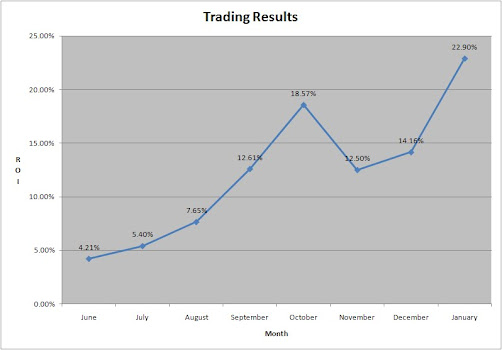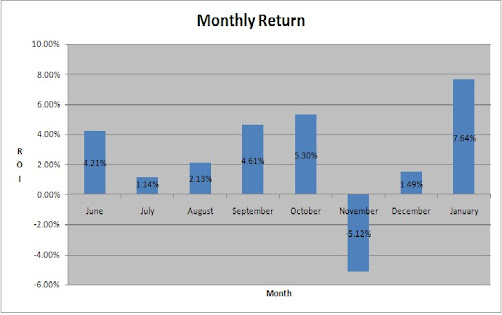A third pair is chosen as the trigger for entries and exits because it is a combination of the two traded pairs. I watch this pair for movements of a minimum size to enter a position. If the trigger moves up the required amount I will enter a short position in both traded pairs, if it moves down instead I will enter a long position. When/if after my entry the trigger pair moves back towards the starting price I will close the position. That is the main theory of the strategy, the price will revert to the mean over time.
What is being traded?
EUR/USD and USD/CHF pairs.
Trigger for entries/exits?
EUR/CHF.
Schedule for entries/exits?
1lot -0.25( or +0.25 of course)
lot 2 -0.25
lot 3 -0.25
lot 4 -0.50 exit 0.25 pull back (pb)
lot 5 -0.50 exit 0.25pb
lot 6 -1 exit 0.50 pb
lot 7 -1 exit 0.50 pb
lot 8 -2 exit 1 pb
lot 9 -2 exit 1 pb
lot10 -3% double lots exit 2pb.
A lot is also referred to as a position and consists of the combination of both traded pairs entered at a specific time. The -.25 is referring to a percentage move so I'm looking for the EUR/CHF to move +/- .25% from the closing price before entering the first position and so on. Unless otherwise specified above I close a position when it retraces .25% in the direction of the trade.
Ratio of EUR/USD to USD/CHF?
The goal is to be as close to U.S. Dollar neutral as possible because that helps to eliminate one more risk to the portfolio. When entering a trade I check to see what the EUR/USD is trading at because this is used as a quick reference on the ratio I want to maintain. As an example if the EUR/USD is trading at 1.50 then every position is long/short 100,000 Euros and short/long 150,000 Dollars. I want to cover these 150,000 Dollars so I will buy 1.5 units of USD/CHF for every 1 unit of EUR/USD. This means my effective trade could be long 100,000 Euros, short 150,000 Dollars and long 150,000 Dollars, short 116,000 Swiss Francs (assuming the USD/CHF is trading at 1.16). It isn't important how many more or less Euros or Francs are in each position, just that as much of the Dollar risk is hedged out as possible.
Size of each position?
I stay between 3 and 3.5% of the total portfolio value for each position. So for each $100.00 in the account I only want to start with $3.00 to $3.50 total between both pairs. The reason for this is that the price doesn't always revert back to the mean immediately, sometimes it can move against me for quite a while so I need to have the capacity to open more positions and not get a margin call. The second important fact that impacts the size is the ratio mentioned above.
Time frame and what to use as a starting point?I only use a 1 hour chart of the EUR/CHF but it doesn't really matter much. As far as a starting point to determine how far away from the mean the price moves I use the GMT 0:00 opening price as my starting point (this is the open of the bar at 7pm EST).
When I trade?
I try and watch the market as much as possible but the best times seem to be from the opening of the London session to mid-afternoon in the U.S.


No comments:
Post a Comment